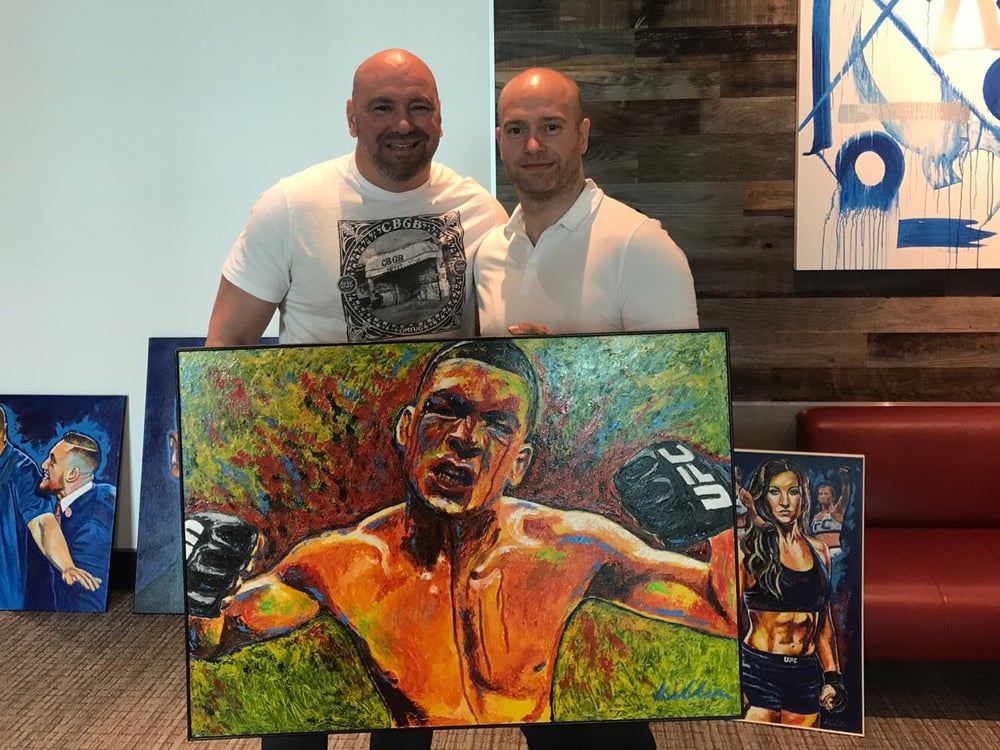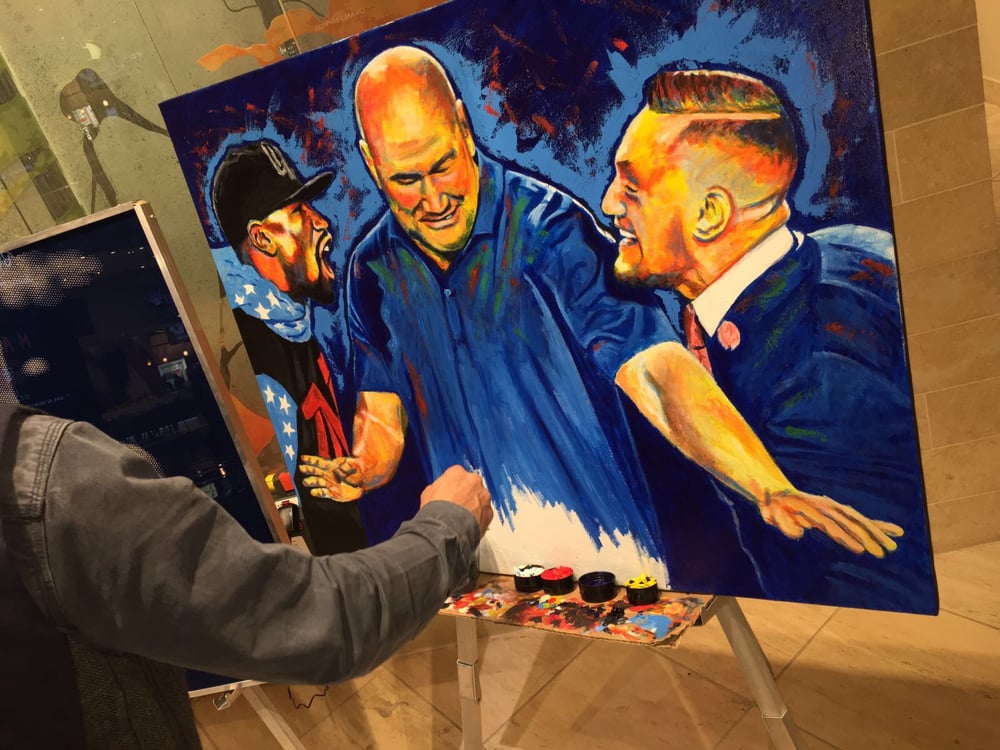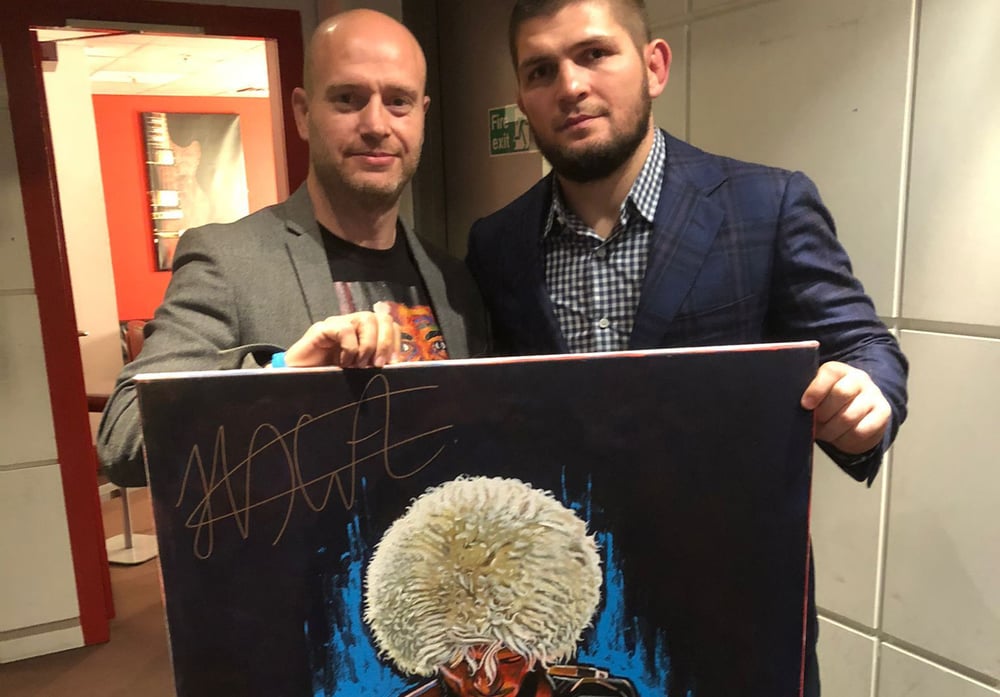
Issue 194
September 2021
Every work of art is born from a spark of inspiration. Our incredible Khabib Nurmagomedov cover is no exception. This is the story of how artist Patrick Killian became one of the best in the world at capturing champions and the essence of the fight game.
For Michelangelo, it was the intricacy of human form. For Warhol, the ordinariness of everyday objects. For Banksy, it was opposing the establishment. Every artist has their muse and for Patrick Killian, it has and always will be fighters.
He has become world-renowned for this skill, thanks to his unique ability to capture on canvas the spirit, intensity, and humility of the world’s greatest combat sports people. Not only does he paint them, but the fighters are so in awe of his work that they go a step further to sign, buy and endorse his incredible skills. Why? Because he’s been one of them from the very beginning.
“I’m a Welshman and had a natural artistic talent from an early age,” says Killian when asked about his career.
“At the age of 16, I got into boxing because it was always something I’d always watched with my dad. I began in my boxing instructor’s garage and in nearby fields because there were no boxing gyms around.
“At age 18 I had my first fight and kept winning until eventually I represented my country. At the same time, I continued my passion for art, and I was increasingly inspired by fighters. This began to shine through in my work.
“While I boxed for Wales on the weekends, I was using the same beaten-up hands to paint beautiful pictures during the week. Eventually, I had to choose between becoming a professional boxer or an artist. It was a tough decision, but my skillset was always greatest when had the paintbrush in my hand.” Having a phenomenal artistic portfolio is one thing but as Patrick will tell you, turning it into something you get paid for is something else altogether.

Artistic clinch
Getting eyes on your art is the driving force between success and failure for any creative, but it doesn’t come without hustle. This is something Patrick knows inside out.
“I had a very loving upbringing and wanted to use those roots to help troubled youths,” he recalls. “To achieve this, I qualified to become a youth worker which became my steady job and let me finance my art materials while trying to get recognized as an artist. To put my work out there I tirelessly displayed at just about every boxing event in the UK for decades and did the same for many fights in Vegas. This was where my opportunities came through where I had the likes of people like Dana White buying my artwork.”
Patrick’s success wasn’t overnight. It was born of incremental improvements, but his determination was something his fighting experience gave him in spades.
“Promoting my work was like a cliched scene from a Rocky movie because I used the mindset that being a boxer taught me,” he smiles. “In the beginning, it didn’t matter how many times I got knocked back. I played by the rules that when life beats you down, you’ve just got to get up and keep going forward. I made sure I pushed
through the setbacks, over and over. It’s not been easy for me. I know artists who gave up because they weren’t selling. That’s where boxing helped me to find the opportunity for success. After getting retrenched from my youth worker job, I decided to become a full-time artist because that’s where my passions lay. To this day I still give a portion of many of my sales to the Amelia-Mae Foundation, a children’s cancer foundation.”
Killian continues to give back as a thank-you for all the support he’s received.

Forever upskilling
Boxing may have been king the hill in the 1990s but as the formerly underground mixed martial arts became more mainstream, this created more awareness around this sport’s skillsets. Not one to fall behind, Patrick was an early adopter.
“In 2006, I had a girlfriend who was into Aikido,” explains Killian. “I know it’s a martial art that gets ripped into, but I signed up for it and loved doing it. As a boxer, I understood how to face up to an opponent but couldn’t do anything if someone grabbed me. This is what Aikido taught me and I eventually got my black belt in it then moved on to practicing jiu-jitsu and judo for many years. After a few injuries, I’m back to boxing. When it comes to the professionals, I feel that the difference between the sports is that it doesn’t matter if you take a loss in the UFC. You can lose, have fight of the night, and won’t lose your opportunity to be top draw. With boxing, when you lose, you go back down the pile. If you lose a title shot, then you must build yourself back up again.”
It’s these insights that have helped give him the understanding and appreciation for both sides of the combat arts.

Capturing the greatest
It’s easy to copy a photo, but it’s something else to have a deep understanding of the subject matter so you see the micro details other people may miss.
“All my fight experience means I know where the shots are coming from and whether or not the body shape looks correct. This knowledge helps me capture the fighter’s fire and intensity. It’s why I almost always use bright colors in my work which I feel highlight it. For Khabib, I love the pop and feel that the blue brings to the piece. It’s the exact color I sign my name in across my work because I just love it. I have felt the emotions that a fighter is feeling, and I wanted to let that come through on the canvas. Khabib was one of my favorite muses because he’s so unusual in that he’s undefeated. I wanted to add this pizzazz for the cover and since he’s retired, it needed to be something that was seen as both a celebration of his career as well as a full stop at the end of an era.”
You can bet with Patrick’s skills he may be hard-pressed to ever find a more unique subject matter than Khabib. From one fighter to another, theirs is a rapport that will forever be inked in greatness.
To see more of Patrick’s artwork visit: killianart.com or follow him on instagram @killian_art or twitter @Pat_KillianArt.
...









